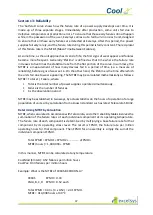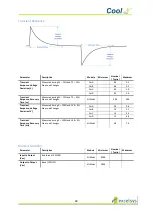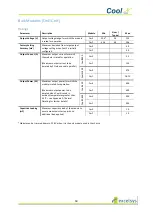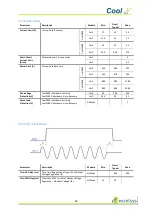
37
Section 13: Reliability
The 'bath-tub' curve shows how the failure rate of a power supply develops over time. It is
made up of three separate stages. Immediately after production, some units fail due to
defective components or production errors. To ensure that these early failures do not happen
while in the possession of the user, Excelsys carries out a full burn-in on each unit, designed
to ensure that all these early failures are detected at Excelsys. After this period, the power
supplies fail very rarely, and the failure rate during this period is fairly constant. The reciprocal
of this failure rate is the MTBF (Mean Time Between Failures).
At some time, as the unit approaches its end of life, the first signs of wear appear and failures
become more frequent. Generally 'lifetime' is defined as that time where the failure rate
increases to five times the statistical rate from the flat portion of the curve. In summary, the
MTBF is a measurement of how many devices fail in a period of time (i.e. a measure of
reliability), before signs of wear set in. On the other hand, the lifetime is the time after which
the units fail due to wear appearing. The MTBF may be calculated mathematically as follows:
MTBF = Total x t / Failure, where
•
Total is the total number of power supplies operated simultaneously.
•
Failure is the number of failures.
•
t is the observation period.
MTBF may be established in two ways, by actual statistics on the hours of operation of a large
population of units, or by calculation from a known standard such as latest Telecordia SR-332.
Determining MTBF by Calculation
MTBF, when calculated in accordance with Telecordia, and other reliability tables involves the
summation of the failure rates of each individual component at its operating temperature.
The failure rate of each component is determined by multiplying a base failure rate for that
component by its operating stress level. The result is FPMH, the failure rate per million
operating hours for that component. Then FPMH for an assembly is simply the sum of the
individual component FPMH.
Total FPMH = FPMH1 + FPMH2 + ………….. +FPMHn
MTBF (hours) = 1,000,000 ÷ FPMH
In this manner, MTBF can be calculated at any temperature.
CoolMod (CmA-D): 0.52 failures per million hours
CoolPac: 0.33 failures per million hours
Example: What is the MTBF of CX18S-BCCD00-N-A?
CX18S
FPMH = 0.33
CMA, B, C, D FPMH = 0.52 each
Total FPMH = 0.33 + (4 x 0.52) = 2.41 FPMH.
MTBF = 414,938 hours at 40°C
Содержание CoolX1800
Страница 29: ...29 ...
Страница 70: ...70 Appendix 4 Mechanical Drawings CoolX1800 1 x Bulk Module 1 x Dual Module 2 x Standards Modules ...
Страница 71: ...71 CoolX1800 2 x Bulk Modules ...
Страница 72: ...72 CoolX1800 6 x Standard Modules ...
















































